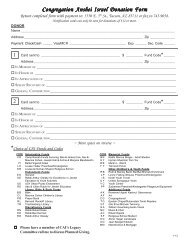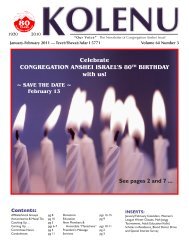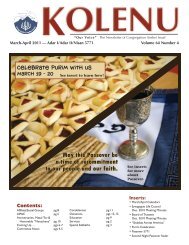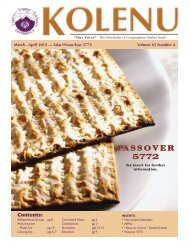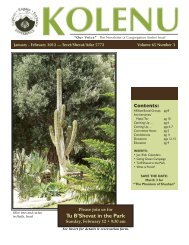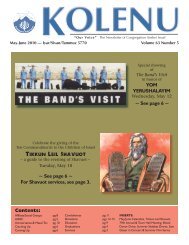July - August 2012 - Congregation Anshei Israel
July - August 2012 - Congregation Anshei Israel
July - August 2012 - Congregation Anshei Israel
Create successful ePaper yourself
Turn your PDF publications into a flip-book with our unique Google optimized e-Paper software.
Shiv’A ASAr B’tAMMUZ<br />
The 17 th of Tammuz is observed as a fast commemorating the breaking down of the<br />
wall of Jerusalem by Nebuchadnezzar and the cessation of Temple worship during<br />
the siege of Titus. It ushers in the three weeks of mourning which end with Tisha<br />
B’Av, the fast of the ninth day of Av.<br />
The three weeks between Shiv’a Asar B’Tammuz and Tisha B’Av are referred to as<br />
“between the straits,” a phrase borrowed from Lamentations 1:3. The Mishnah<br />
mentions five misfortunes that befell the Jewish people on the 17 th of Tammuz and<br />
five on the ninth of Av (Ta’Anit 4:6).<br />
The three weeks are concluded with the so-called Nine Days, from the first to the<br />
ninth of Av, during which the mourning is intensified until Tisha B’Av itself — the<br />
saddest day of the Jewish year.<br />
this year the 17 th of tammuz falls on <strong>July</strong> 8.<br />
ShABBAt hAZon and ShABBAt nAhAMU<br />
The Sabbaths surrounding the Ninth of Av carry a clear message relating to the<br />
holiday. The prophetic readings for the three weeks preceding the holiday — the<br />
first two from Jeremiah and the third from Isaiah — are full of admonitions in<br />
preparation for this mournful time. Following Tisha B’Av, there are seven prophetic<br />
readings of consolation — all from Isaiah — providing comfort after this somber<br />
occasion and preparing the individual emotionally and spiritually for the upcoming<br />
High Holy Days. The Sabbaths that immediately precede and follow Tisha B’Av each<br />
have a special name reflecting the message of the respective Haftarah (prophetic<br />
reading).<br />
The Sabbath immediately preceding the Ninth of Av is known as the Sabbath of<br />
Vision (Hazon) for the prophetic reading Isaiah 1:1-27. After recounting heinous<br />
transgressions, it offers the hope of reconciliation, which will come when the<br />
people “cease to do evil, learn to do good.” The Sabbath of Vision and Shabbat<br />
Nahamu, which provides words of consolation a week later, embrace Tisha B’Av<br />
from opposite sides, cushioning the blow of the day of destruction, allowing the<br />
mourners to go into it knowing there is salvation and emerge from it reassured that<br />
redemption will come. The entire portion [of Shabbat Hazon] may be chanted to the<br />
melody of Eicha (Lamentations); more appropriately, only the verses of admonition<br />
are rendered in the subdued chant.<br />
The upswing of hope begun on the afternoon of Tisha B’Av continues on the<br />
following Shabbat. Called Shabbat Nahamu (Console) after the first line of the day’s<br />
prophetic reading (Nahamu, Nahamu Ami, Console, console my people …”) (Isaiah<br />
40:1-26), it is also the first of seven Haftarot of consolation, all drawn from the book<br />
of Isaiah, that deliver a message of comfort in the seven weeks following Tisha B’Av<br />
and lead us to the period of Rosh Hashanah (49:14-51:3; 4:11-55:5; 1:12-52:12; 4:1-<br />
10; 60:1-22; 61:10-63:9).<br />
this year Shabbat Hazon falls on <strong>July</strong> 28; Shabbat Nahamu falls on<br />
<strong>August</strong> 4.<br />
tiShA B’Av<br />
The ninth day of Av, mentioned in Zechariah 8:19 as the “Fast of the Fifth” month,<br />
commemorates such national calamities as the destruction of both Temples, the fall<br />
of Bar Kokhba’s fortress, Bethar, and the expulsion from Spain in 1492. According to<br />
tradition, both the First and Second Temples were destroyed on the ninth of Av, the day<br />
referred to as predestined to misfortune. Tisha B’Av resembles Yom Kippur in its<br />
restrictions upon eating and bathing, maintained from sunset to sunset.<br />
The three weeks between the 17 th of Tammuz and the ninth of Av are observed by<br />
abstaining from all festivities and joyous celebrations. But when the month of Av has<br />
begun, all enjoyment should be reduced. It has long been the custom in <strong>Israel</strong> to eat<br />
no meat (except on the Sabbath) from the first day of Av until after the fast.<br />
On the ninth of Av, when the Book of Lamentations and other dirges<br />
(kinot) are recited, before congregations seated on low stools as a sign of<br />
mourning, the curtain (Parokhet) is removed from the Ark (Aron Ha-Kodesh),<br />
and visits are made to cemeteries, in order to stress the sense of mourning.<br />
The morning service is recited without tallit or tefillin; these are worn during<br />
the Mincha service. The elegies known as kinot are descriptive, not only of the<br />
calamities connected with the destruction of Jerusalem, but also of the Jewish<br />
catastrophes that occurred in various lands of persecution.<br />
this year, the ninth of Av observance/fast begins on the evening of<br />
Saturday, <strong>July</strong> 28 and continues through Sunday, <strong>July</strong> 29.<br />
www.caiaz.org<br />
Our New MeMbers:<br />
Please warmly welcome...<br />
Hilary & Patrick Lyons<br />
and their children,<br />
Aodhan, Ezra, Orson & Ellis<br />
Amy & Benjamin Pozez<br />
and their son, Evan<br />
Harriet Silverman<br />
Ruth & Arthur Solomon<br />
Bronwyn & Lonny Sternberg<br />
and their son, Alston<br />
The Mitzvah of<br />
Bikur Holim<br />
Federal health-care privacy<br />
regulations make it difficult for us<br />
to know when a member of CAI<br />
has been admitted to a hospital.<br />
Become a partner in the mitzvah of<br />
Bikur Holim — visiting the sick —<br />
by advising our clergy when you, a<br />
relative, or a friend is hospitalized.<br />
We can stay informed ONLY if a<br />
family member or friend provides<br />
the information to us.<br />
PLEASE CALL 745-5550:<br />
Rabbi Robert Eisen, X230<br />
Clergy Secretary, X225<br />
thank you to our<br />
“Yad Squad”<br />
(Those who read Torah and<br />
Haftorah May & June <strong>2012</strong>)<br />
Marlene Abraham<br />
Rebecca Auslander<br />
Rev. Nachman<br />
Berkowitz<br />
Noah Deitch<br />
Rabbi Robert Eisen<br />
Rayna Gellman<br />
Margo Gray<br />
Richard Green<br />
Rabbi Ben Herman<br />
Mike Jacobson<br />
Dan Karsch<br />
Shaun Kozolchyk<br />
Jenna Langert<br />
Natalie Leonard<br />
Nancy Ozeri<br />
Phil Pepper<br />
Helen Rib<br />
Myron<br />
Rottenstein<br />
Ann Rush<br />
Ron Sandler<br />
Leonard Schultz<br />
Steve Seltzer<br />
Andrea Shatken<br />
Alan Strauss<br />
Molly Szerlip<br />
Sidney Szerlip<br />
Moshe Toister<br />
Abigail Tolby<br />
Leah Tolby<br />
Jacob Weinstein<br />
Arthur Zoref<br />
Kolenu <strong>July</strong> - <strong>August</strong> <strong>2012</strong> — Tammuz/Av/Elul 5772 Page



